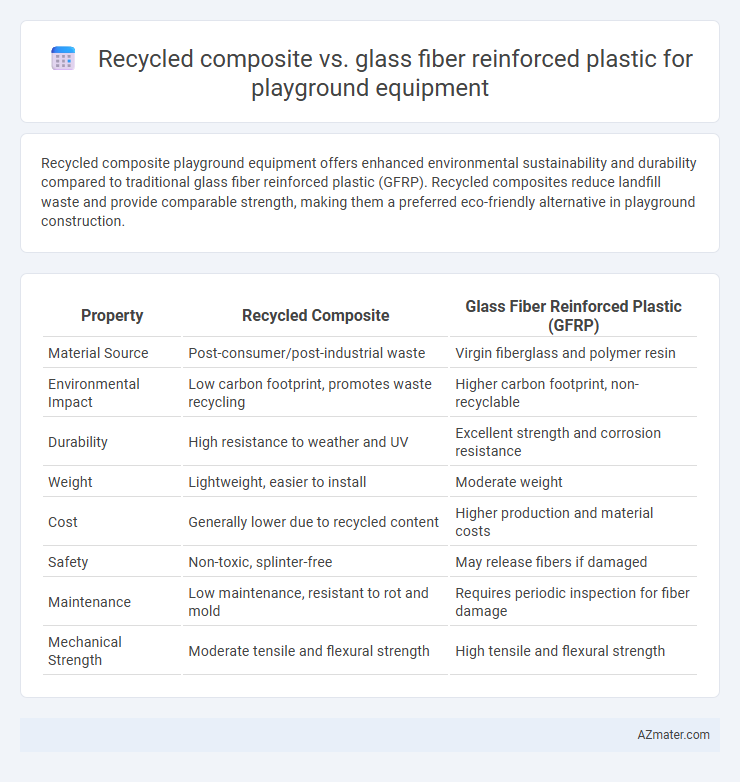Recycled composite playground equipment offers enhanced environmental sustainability and durability compared to traditional glass fiber reinforced plastic (GFRP). Recycled composites reduce landfill waste and provide comparable strength, making them a preferred eco-friendly alternative in playground construction.
Table of Comparison
| Property | Recycled Composite | Glass Fiber Reinforced Plastic (GFRP) |
|---|---|---|
| Material Source | Post-consumer/post-industrial waste | Virgin fiberglass and polymer resin |
| Environmental Impact | Low carbon footprint, promotes waste recycling | Higher carbon footprint, non-recyclable |
| Durability | High resistance to weather and UV | Excellent strength and corrosion resistance |
| Weight | Lightweight, easier to install | Moderate weight |
| Cost | Generally lower due to recycled content | Higher production and material costs |
| Safety | Non-toxic, splinter-free | May release fibers if damaged |
| Maintenance | Low maintenance, resistant to rot and mold | Requires periodic inspection for fiber damage |
| Mechanical Strength | Moderate tensile and flexural strength | High tensile and flexural strength |
Introduction to Playground Equipment Materials
Playground equipment materials have evolved to prioritize durability, safety, and environmental impact, with recycled composites and glass fiber reinforced plastic (GFRP) emerging as leading options. Recycled composites combine plastic waste with wood fibers or other fillers, offering enhanced resistance to weather and reduced environmental footprint. GFRP provides superior strength, lightweight properties, and corrosion resistance, making both materials suitable for long-lasting and safe playground structures.
What is Recycled Composite?
Recycled composite for playground equipment is a sustainable material made by repurposing post-consumer plastics and wood fibers, creating a durable and eco-friendly alternative to traditional materials. Unlike glass fiber reinforced plastic (GFRP), which combines plastic with glass fibers for high strength and rigidity, recycled composites emphasize environmental benefits by reducing waste and minimizing carbon footprint. The use of recycled composite ensures resistance to rot, corrosion, and UV damage, making it ideal for safe and long-lasting playground structures.
Overview of Glass Fiber Reinforced Plastic (GFRP)
Glass Fiber Reinforced Plastic (GFRP) is a robust composite material combining glass fibers with a polymer matrix, known for its high strength-to-weight ratio and corrosion resistance. Widely used in playground equipment, GFRP offers durability, low maintenance, and resistance to environmental stressors such as UV radiation and moisture. Its structural integrity ensures long-lasting performance, making it a popular choice compared to traditional materials like wood or recycled composites.
Durability: Recycled Composite vs GFRP
Recycled composite materials outperform glass fiber reinforced plastic (GFRP) in playground equipment durability due to their enhanced resistance to moisture, UV exposure, and impact damage. The fiber-matrix bonding in recycled composites reduces susceptibility to cracking and delamination compared to the brittle nature of GFRP. Long-term usage data indicates recycled composites maintain structural integrity and aesthetic appeal longer, decreasing maintenance frequency and lifecycle costs.
Environmental Impact and Sustainability
Recycled composite materials for playground equipment significantly reduce environmental impact by repurposing waste such as plastic and wood fibers, cutting down on landfill usage and reducing the carbon footprint compared to traditional glass fiber reinforced plastic (GFRP). Glass fiber reinforced plastic relies heavily on non-renewable resources and involves energy-intensive manufacturing processes that contribute to higher greenhouse gas emissions and challenges in recycling. Opting for recycled composites enhances sustainability through improved resource efficiency, lower embodied energy, and easier end-of-life recyclability, making them a more eco-friendly choice for playground construction.
Safety Standards and Child-Friendliness
Recycled composite materials for playground equipment offer enhanced safety standards by incorporating non-toxic, splinter-free surfaces that reduce injury risk, meeting ASTM F1487 and EN 1176 certifications. Glass fiber reinforced plastic (GFRP) provides strength and durability but may pose concerns due to potential fiber exposure if damaged, requiring stringent protective coatings and regular inspections to ensure child-friendliness. Both materials comply with impact attenuation requirements, but recycled composites often excel in sustainability and tactile comfort, promoting a safer, more environmentally responsible playground environment.
Maintenance Requirements and Lifespan
Recycled composite playground equipment generally offers lower maintenance requirements compared to glass fiber reinforced plastic (GFRP) due to its enhanced resistance to moisture, UV degradation, and corrosion, reducing the need for regular repairs or repainting. The lifespan of recycled composites often exceeds that of GFRP, with durability extending beyond 20 years under typical outdoor conditions, whereas GFRP may show signs of wear and structural fatigue within 15 to 20 years. These characteristics make recycled composite materials more cost-effective over the long term for playground installations.
Cost Analysis and Installation
Recycled composite playground equipment generally offers a lower initial cost compared to glass fiber reinforced plastic (GFRP), with savings stemming from the use of sustainable materials and simplified manufacturing processes. Installation of recycled composite components tends to be faster and less labor-intensive due to their lighter weight and modular design, reducing labor costs and on-site assembly time. While GFRP provides superior strength and durability, the higher material and installation expenses can make recycled composites a more cost-effective choice for budget-conscious playground projects.
Design Flexibility and Aesthetic Options
Recycled composite materials offer enhanced design flexibility for playground equipment, allowing for intricate shapes and custom textures that mimic natural wood while maintaining durability. Glass fiber reinforced plastic (GFRP) provides high strength and rigidity but is more limited in molding complexity compared to recycled composites. Aesthetically, recycled composites deliver a wider range of color options and surface finishes, enabling vibrant, eco-friendly designs that appeal to both children and caregivers.
Choosing the Best Material for Playground Equipment
Recycled composite materials offer superior environmental benefits and corrosion resistance compared to glass fiber reinforced plastic (GFRP), making them ideal for sustainable playground equipment. GFRP provides excellent strength-to-weight ratio and durability but may pose challenges in terms of recyclability and potential environmental impact. Selecting the best material involves balancing factors such as structural performance, safety standards, maintenance requirements, and ecological footprint to ensure long-lasting, safe, and eco-friendly playground installations.

Infographic: Recycled composite vs Glass fiber reinforced plastic for Playground equipment
 azmater.com
azmater.com